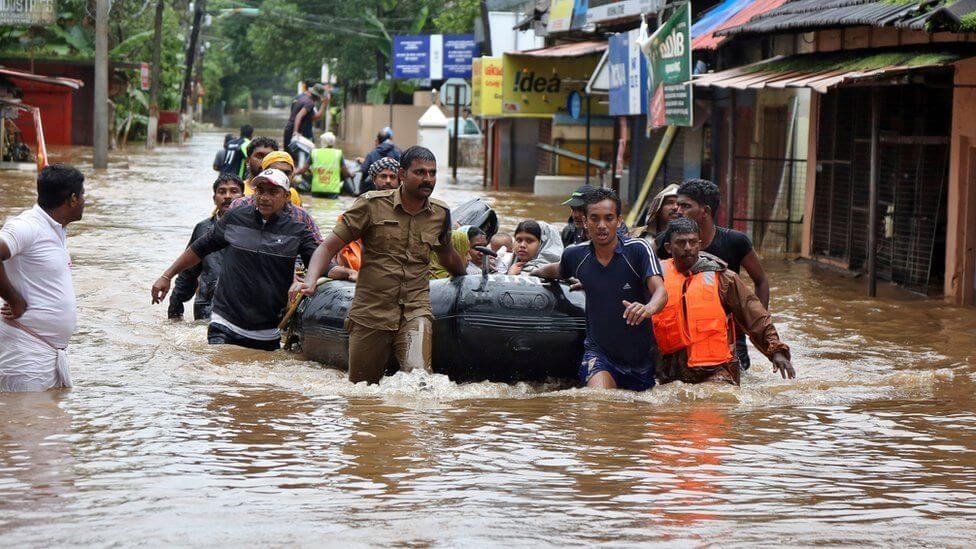- September 4, 2018
- Posted by: Neha Yadav
- Category: CLIMATE CHANGE AND ENVIRONMENT, Featured, Latest Work, NATURAL HAZARDS, OPINION

The ensuing flood causes loss of over 400 lives besides causing severe damage to property of about 20,000 crores. Nine of the 14 districts were worst hit and have been ravaged by flood waters, landslides, or both. According to the government, there hasn’t any flood of this magnitude occurred in the last nine decades. In the past, the most horrific floods in Kerala occurred in 1924 then there was record 3368mm rainfall in the state. The state remains flooded for three weeks.
India’s most picturesque and highly rated state in human development index ‘Kerala’ the incredible God’s own country lurched under the devastating monsoon floods. Under the proclivity of development lies high population dense regions and the highest number of buildings per unit of land area in India. Gilbert White, a well-known hydrologist, used to say that ‘God makes floods, but flood disasters are made by humans’.
Excessive Precipitation
The state has received 37.5 percent excess rainfall in the two and half months since the south-west monsoon made landfall in May end. Some districts such as Idukki have received 83.5 percent excess rainfall. The August rainfall in the state is 2.5 times the normal for the period. On 16 August Kerala received 137mm rainfall, ten times more than average in one day. Till August 17, average rainfall was 175 percent more than normal. If one compares the events of rainfall departure from the normal from 1875 onwards in 1931 rainfall in Kerala in August was 175 percent excess than the normal after that this is the year in which Kerala got excess precipitation.
No Scientific Reservoir Management
There are 44 rivers in Kerala, 41 of them originated in the Western Ghats and flowed westward to meet the Arabian Sea, and there are 43 major dams on these rivers. The intense rainfall (August 15-17, 414mm) resulted in all the dams filling up to the capacity, which compelled the authority to open the floodgates of 33 dams and release the excess water that inundated the low lying areas and causes the enormous humanitarian crisis. The Idukki dam, which is Asia’s largest arch dam, has released water at the rate of 10-15 lakhs per second for three days, it compounded the misery already caused by the excess precipitation.
On questions, why were dams spillways not opened earlier to create a holding capacity to absorb additional rainfall upstream, which could have abridged the intensity of the flood below the dams? The flood operators have no convincing answer except to blame the weather forecast.
Muralee Thummarukudy, operation managers at Post Conflict and Disaster Management branch of United Nations Environment Programme, said: “modeling of reservoirs only needs rainfall trends and not precise long-term forecasts”. In the wake of this flood event, he assumed the latest tools of reservoir management are not available to dam and reservoir managers in Kerala.
No Flood Forecasting by CWC
Kerala received no early flood warning from the Central Water Commission (CWC), the lone government agency sanctioned to do so. It was shocking to discover that the agency has no flood forecasting sites, it has only flood monitoring sites in Kerala. The CWC director of flood forecast monitoring said unlike other states, ‘Kerala did not submit a proposal for setting up flood forecasting stations’. The CWC is primarily into flood forecasting; flood risk analysis is underneath the area of State government, which has to frame its flood management plans grounded on that analysis.
The Recommendation has been Ignored and Diluted
In 2010, then environment minister Jai Ram Ramesh attended a public meeting organized mainly by those associated with ‘Save the Western Ghats’ group. Speakers pointed out the threats to the ecosystem from construction, mining, industries, real estate, hydro-power was discussed. The minister set-up a Western Ghats Ecology expert panel under Madhav Gadgil, the panel was asked to make assessment on ecology and biodiversity of the Western Ghats and suggest measures to conserve, protect and rejuvenate the entire range that stretches to over 1500 km along the states of Gujarat, Maharashtra, Goa, Karnataka, Kerala and Tamil Nadu.
The committee declared the region ecologically sensitive and had strongly recommended a ban on certain new industrial and mining activities in the area and called for strict regulation on developmental works.
The report met with resistance, and none of the six states agreed with the recommendation of the Committee report. In August 2012, a High-level working group on the Western Ghats was constituted under Kasturirangan to examine Gadgil Committee report in a holistic and multi-disciplinary manner in the light of rejoinders received from states, central ministries, and others. The committee in its report, sternly watered down the commendations of the Gadgil panel, efficiently signifying that only a third of the Western Ghats be recognized as being ecologically sensitive.
Environmental experts say had the report of Gadgil committee been implemented to preserve the ecologically fragile area then such tragedy could have been limited.
The Rainfall Pattern Seems to have Changed Much
During the South-West monsoon season (officially extends from June 1 to September 30), there is an increase in the frequency of heavy rainfall and which is not confined to some region; this is happening throughout the country. IMD official data for the last three decades suggest many cities in India get nearly their total rainfall of the season in a small window that sums up to just a few days to a few weeks. In 22 cities, 95 percent of monsoon precipitation occurs over three days to 27 days on average. For example, Delhi receives 95 percent of its monsoon rainfall in just 99 hours. Mumbai gets 50 percent of its monsoon rainfall in only five and half days.
Scientists said if we analyze the overall monsoon rainfall, there isn’t much change (year to year there may be change), and monsoon rainfall has been stable over the last 50 years. This increase in the intensity of rain, on the daily and hourly basis, is related to global warming.
Does Extreme Weather Events Relate to Climate Change?
The studies related to temperature proposes, the Indian Ocean has been warming, particularly the Arabian seaside at the fastest rate. For India, most of the water vapors and the subsequent precipitation comes from the Indian Ocean. The cyclones in the Arabian Sea was previously limited to the Gujarat state, the changes occurred in the past ten years made Kerala and Karnataka more vulnerable to the cyclones, the recent example is Ockhi. The Secretary of the Ministry of Earth Sciences Dr. Rajeevan said “weather prediction is robust, but in the last ten years, we have improved a lot regarding modeling. At the same time, climate change has added another component to the difficulties in weather prediction as it can add to the uncertainty”.
Concluding Remark
In India, most of the flood management systems are not reinforced by science. No decision support system is available, except perhaps in, Bhakra Nangal dam. We essentially require full-fledged flood management systems using scientific methods for all the major rivers. At present, a qualitative forecast is prearranged at the district level for at least three-four days, bearing in mind the imperative need it should be well included in the models that can estimate probabilities as well like whether the rainfall will increase or decrease in the next few days. It is very useful for farmers and could be supportive is deciding an efficient disaster preparedness plan. Some parts of Kerala have been stranded because wetlands and lakes that represented as natural safeguards counter to floods have died out because of extensive urbanization and construction of infrastructure. There is an urgent need to make a policy-level decision that supports stringent laws against the offenders to avoid mining and industrial activities in the ecologically sensitive region and rampant construction in the cities. It is high time for the decision makers to think aggressively when climate change seems to be inevitable, what measures should be taken to mitigate climate extremes and disasters to reduce the destruction and misery.

